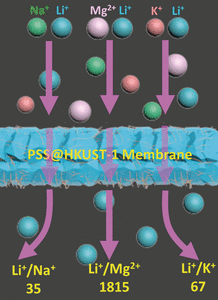Nov 3 2016
The increasing usage of lithium for batteries or high-performance metals requires improved extraction techniques of lithium from primary sources such as salt lake brines. Chinese scientists have now designed a solid composite membrane that combines the mimicking of the chemical selection process in biological ion channels with molecular sieve technology. In the journal Angewandte Chemie, they report the effective and fast separation of lithium ions from brines with that membrane.

Lithium is an earth-abundant element, but it usually coexists with the chemically very similar elements sodium, magnesium, and potassium. Although a variety of techniques have been attempted to selectively extract the lithium ions from salt lake brines, a truly economical, environmentally benign, selective, and efficient method is still elusive. Xinsheng Peng and Banglin Chen at Zhejiang University of Hangzhou, China, and The University of Texas at San Antonio, USA, have investigated a combined selection process by both chemical affinity and molecular sieving. Their separating membrane consisted of a functionalized linear polymer integrated in a porous metal organic framework, and they obtained excellent lithium ion conductivity with the retention of interfering ions.
For a basic membrane material, the scientists employed the metal–organic framework HKUST-1, which through its porosity is a molecular sieve, blocking out larger contaminants. For the lithium affinity selection, they integrated polystyrene sulfonate (PSS) in the solid network, which is an organic linear polymer bearing functional groups known for their excellent conductivity for lithium ions compared to other ions. "Their ionic conductivity ratios between different cations are typically considered as the ideal separation factors," the scientists wrote.
The PSS polymer was interwoven in the HKUST-1 scaffold by a two-step process: firstly it was firmly assembled with the HKUST-1 precursor, then the composite was converted into the final PSS@HKUST-1 membrane. The produced composite solid membrane thus combined the molecular sieving characteristics with chemical selection functionality.
The scientists indeed reported an outstanding selectivity for lithium over the related ions of sodium, potassium, and magnesium, and a fast lithium ion flux. And the size-exclusion effect by the porous framework membrane only allow the small ions to pass, barring other contaminants such as heavy metals. And the approach could be universally adopted. The authors propose that it "can be applied to other polymer-functionalized MOF-based membranes." There are thus good prospects for more effective lithium separation from salt lakes.